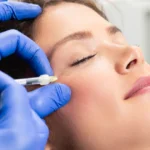Table of Contents
If you’ve been curious about the benefits of chemical peels, their different types, and how they can transform your skin, you’ve come to the right place. In this ultimate guide, we’ll explore everything you need to know about chemical peels, including their benefits and types, and how to determine which one is right for you. Plus, we’ll explain why Cultivated Beauty is your go-to destination for a personalized and safe chemical peel experience.
What Are Chemical Peels?
Chemical peels are cosmetic treatments that use an acid solution to exfoliate the skin. These solutions remove the damaged outer layers, promoting cell turnover and revealing fresher, healthier skin beneath. Depending on the type of peel, it can target various skin concerns, such as fine lines, wrinkles, acne scars, hyperpigmentation, and sun damage.
Chemical peels are an excellent option for people looking to improve the texture and appearance of their skin without invasive procedures. They can be performed on the face, neck, hands, and even the back, making them versatile treatments for localized and widespread concerns.
How Chemical Peels Work
Chemical peels work by applying a chemical solution that causes the outermost layer of your skin to exfoliate and eventually peel off. Once this layer is removed, the new skin that replaces it is typically smoother, less wrinkled, and more evenly toned. The strength and depth of the peel can be adjusted based on the type of peel used, which we’ll discuss in more detail below.
Benefits of Chemical Peels
Chemical peels offer many benefits for people of all ages and skin types. Here are some of the top benefits of chemical peels:
Improves Skin Texture and Tone: Chemical peels effectively improve the skin’s overall texture by exfoliating dead cells and encouraging the growth of new ones. This results in a smoother, softer surface and a more radiant complexion.
Reduces Fine Lines and Wrinkles: One of chemical peels’ most desired advantages is their capacity to lessen the visibility of wrinkles and fine lines. The peeling process makes the skin appear firmer and plumper, which also increases the creation of collagen.
Treats Acne and Acne Scars: Chemical peels can be particularly beneficial for those who struggle with acne or post-acne scarring. By removing the damaged skin and promoting cell regeneration, peels can help minimize the appearance of scars while also reducing active acne breakouts.
Fades Hyperpigmentation and Sun Damage: Sunspots, age spots, and other forms of hyperpigmentation can make your skin look uneven and aged. Chemical peels help by removing pigmented skin cells and encouraging the growth of evenly toned skin.
Minimizes Pores: Larger pores can give your skin a rough, uneven texture. Chemical peels work to tighten the skin, making pores appear smaller and less noticeable.
Boosts Skincare Product Absorption: The dead skin cells that serve as a barrier are eliminated after a chemical peel, so your skin will be more responsive to skincare products. This means your serums, moisturizers, and other products can penetrate deeper and work more effectively.
Quick Recovery and Minimal Downtime: Most chemical peels, particularly lighter ones, offer fast recovery times, meaning you can return to your daily routine with minimal disruption. Peels can vary in strength, but many patients report being able to return to normal activities within a day or two.
Types of Chemical Peels
Chemical peels come in three primary varieties, each with varying degrees of exfoliation. Your skin type, concerns, and intended outcomes will all influence the kind you choose.
Superficial (Light) Peels
Superficial chemical peels, often referred to as “lunchtime peels,” are the mildest form of peel and are ideal for people looking for subtle improvements with minimal downtime. These peels use mild acids like alpha-hydroxy acids (AHAs) or beta-hydroxy acids (BHAs), such as glycolic or salicylic acid, to exfoliate only the outer layer of the skin.
Results and recovery: The recovery for superficial peels is typically very quick. You might experience some light peeling or redness, but most patients can resume their daily activities immediately. Results are gradual but noticeable with repeated treatments.
Medium Peels
Medium chemical peels penetrate deeper into the skin, targeting the middle layer to address more significant concerns like deeper wrinkles, moderate hyperpigmentation, and acne scars. Trichloroacetic acid (TCA) is commonly used in medium-depth peels.
Results and recovery: Following a medium peel, you may experience some redness, swelling, and flaking for a few days. Compared to mild peels, the effects are more spectacular, but the full recovery usually takes one to two weeks. After healing, your skin will seem smoother and more uniformly toned.
Deep Peels
Deep chemical peels are the most intensive type of peel and penetrate several layers of skin. Usually made with phenol or high concentrations of TCA, these peels treat more severe skin issues like deep wrinkles, significant sun damage, or precancerous growths.
Results and recovery: Because deep peels involve extensive exfoliation, recovery time is longer, typically around two to three weeks. You may experience swelling, redness, and scabbing during the healing process. However, the results are impressive and long-lasting, with smoother, younger-looking skin that can last for years.
What to Expect During a Chemical Peel Procedure
Understanding what happens during a chemical peel can help you feel more prepared and comfortable. Here’s a step-by-step overview of what you can expect:
- Consultation: Before undergoing any chemical peel, you’ll have a consultation with a skincare professional at Cultivated Beauty to assess your skin and discuss your goals. They’ll help determine the best type of peel for your skin concerns.
- Preparation: On the day of your treatment, your skin will be washed to remove pollutants, oils, or makeup. Depending on the kind of peel, a numbing lotion may be administered to reduce discomfort.
- Chemical Solution Application: Depending on the extent of the peel, the chemical solution is applied to your skin in layers. As the treatment starts to act, you can experience a slight tingling or stinging sensation.
- Neutralization and Removal: After a specific amount of time, the solution is neutralized and washed off. To protect your skin, a soothing moisturizer or ointment is applied.
- Post-Treatment Care: Your skin care specialist will provide aftercare instructions, including moisturizing and protecting your skin. Avoiding direct sun exposure and using a high-SPF sunscreen during recovery is essential.
Book Your Chemical Peels Appointment Now!
Ready to experience the transformative effects of chemical peels? Whether you’re looking to address acne scars, fine lines, or sun damage, the experts at Cultivated Beauty are here to help you achieve your skin goals. With personalized consultations and tailored treatments, we ensure your peel perfectly suits your skin type and concerns.
Book your chemical peel appointment now and take the first step toward healthier, rejuvenated skin. Contact Cultivated Beauty today, and let us guide you through a skincare journey that will leave you glowing inside and out!








